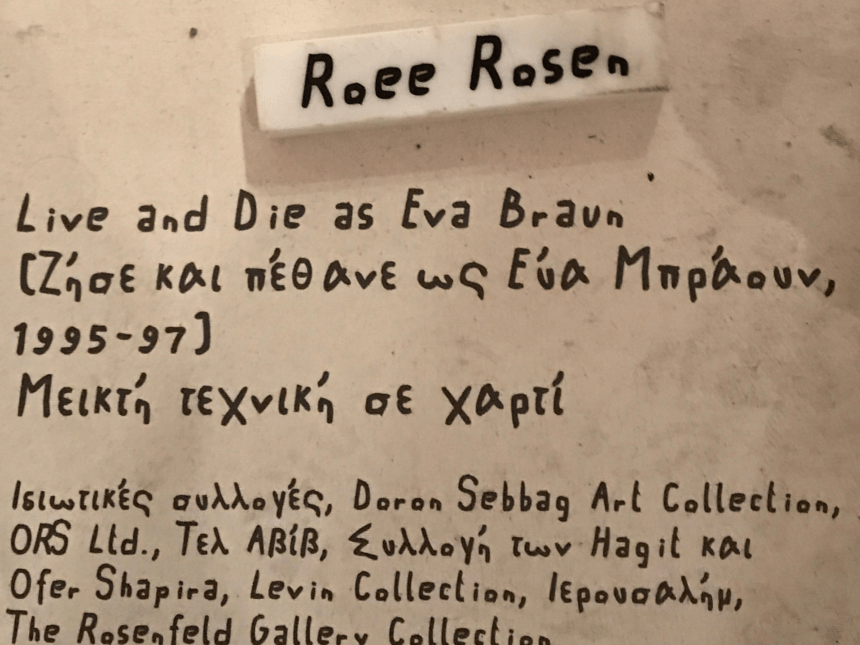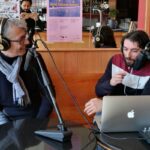Eva in Athens: Documenta 14 and the “Aesthetic Politics” of Humor
Chrisoula Lionis
The local ambivalence felt towards Documenta 14’s presence in Athens is perhaps most clearly reflected in the acid tongued comments of Yanis Varoufakis, who notoriously compared the art festival to a “humanitarian crisis crusade.” [1] The sentiment of the former Finance Minister was also echoed in commentary found in street stencils signed the “i8ageneis” (or the “indigenous”) that dotted across the capital and circulated frequently in reviews of the D14 program. [2] Beginning with the address “Dear Documenta,” these stencils employed a sardonic humor to question the German art festival’s financial and ethical motives, and to frame its presence in Athens as an exercise in the extraction of cultural capital. The overlooked common denominator shared by two frequently cited examples is the use of humor as a means to lay bare the politics underscoring Documenta’s appearance in crisis-ridden Athens.
Humor was not limited to public commentary. For those of us living in the city at the time, it was a response that characterized both the lived experience of the crisis more broadly [3], but also something that pervaded many local community discussions about feelings toward Documenta 14’s presence in Athens. The prevalence of mirth in such a context should not be entirely surprising: the relationship between humor and ambivalence has long been chronicled [4], and for a community receiving major international art industry attention for the first time, there was a palpable sense of being caught in the crossfires of an international gaze that offered as much potential for industry advantage as it did for exploitation.
My intention here is to consider how humor operates as a “political aesthetic” [5]—an aesthetic form that operates as a signifier of cultural politics—which underscores the curatorial decisions of Documenta 14’s Athens iteration. To this end, my focus here is on a single work of art that was consistently raised as a stand out favorite in my discussions with various members of the Athenian art public – Roee Rosen’s mixed media work Live and Die as Eva Braun (1995-1997). Positioned as the first work audiences encountered at the Benaki Pireos Annexe (one of the five primary Athens D14 sites), the work welcomed viewers to a venue (as described on the D14 website) curatorially focused on “untold, unfinished, or otherwise overshadowed histories.” Given the broad scope of geographies from which works of art were chosen for this venue (hailing from Haiti, India, Kosovo, Senegal and Thailand for example), this theme perhaps, not surprisingly, meant that many works on display were focused on collective memory and trauma.
To appreciate the potential of art that deals with trauma, the best approach is arguably to understand it as transactive rather than communicative—which is to say that art may touch or move us, without necessarily requiring the communication of the “secret” of one’s personal experience. [6] This Deleuzian argument (advanced by Jill Bennett) suggests that the involuntary affect facilitated through an artwork produces more than mere sensation—it compels us to interpret and to think. Humor (long appreciated as being intimately braided to trauma), can find itself entangled in this transmission of affect, becoming a vehicle that encourages critical inquiry and complex engagement.
Humor however often misfires. This is to say that although humor is often praised as a weapon of subversion, when misunderstood (or indeed misused) it can serve to affirm the very thing it seeks to undermine. Regrettably it would seem that this was the case in the installation of Roee Rosen’s work in Athens. Taking the form of over sixty works on paper separated by ten sheets containing large blocks of narrative text, the work directly invites the viewer to participate in a virtual-reality “ultimate entertainment experience”—becoming Adolf Hitler’s infamous lover, Eva Braun. Blurring the line between history and fiction, the work invites the viewer to imagine themselves in the position of Braun—as Hitler’s lover, erotic protagonist, and (controversially) as victim. Described as “compelling, horrifying, ludicrous,” [7] the work takes on a pulp erotica aesthetic and language to imagine Braun’s life with Hitler—employing a dark humor that chronicles their intimate relationship, her death, and later descent into hell.
Whereas Rosen’s work is typically characterized by a transgressive humor that relies on self-parody or the performance of various alter-egos, the humor in Live and Die as Eva Braun can be explained through what humorologists refer to as incongruity theory. This is the framework which argues that humor is produced through the perception of an incongruity that does not present an immediate threat. That is to say an unexpected situation, experience, or event that violates our expectations and often denies logic. The humor in Rosen’s work might be argued to operate through numerous incongruities, ranging from pornographic images rendered in a folk aesthetic, to the language of virtual-reality computer games, to Nazi iconography and children’s books, to text that calls upon the language of advertising to directly address the art viewer as consumer, and perhaps the most challenging incongruity of all—a first-person erotic account of the intimate lives of two of the most black-hearted figures in modern history.
Made shortly after the signing of the Oslo Accords (a time of radically changing politics in Israel/Palestine), Live and Die as Eva Braun drew tremendous criticism when first installed at the Israel Museum in Jerusalem where there were demands for its removal. When later installed as part of the Mirroring Evil exhibition at the Jewish Museum in New York in 2002, the work was criticized for two distinct reasons: the first was that it was understood as “repugnant” and “not to be forgiven” for its crude depiction of holocaust themes, and secondly for its failure to deal with the then contemporary issue of the breakdown of peace talks and the outbreak of the second intifada. [8] In other words, the piece became entangled in the politics of when, how and why the memory of collective trauma becomes mobilized.
Despite the strength of Live and Die as Eva Braun and its popularity in D14, the audiences that I spoke with did not know the background of the work, nor were they familiar with Rosen’s practice and his characteristic use of humor to reflect upon the construction of national identity and the memorialization of history. More importantly, they were largely unaware that this chapter of German history was being “played with” by an Israeli artist. It would be unfair to expect audience members to know this background off hand, and they were offered no curatorial aid in this regard; for as was the case across D14 exhibitions in Athens, there was a near total failure to contextualize works, omitting countries of origin, or birth (and death) dates for participating artists. Without this essential contextualization of Rosen’s work (and the work’s own history), the piece was put into a position where it arguably validated the very thing the artist’s practice seeks to undermine: namely the idea of a hierarchy of suffering, the way narratives are instrumentalized to congeal collective identity, and the “appropriate” ways to reflect and mediate the experience of trauma in art practice.
If, as Nicholas Holm suggests, humor is the central site of cultural politics today [5], then the failure to contextualize Rosen’s work means that the laughter of audiences might start to be read as a signifier of contemporaneous politics. [9] What is of particular interest here is the ambiguity created by the absence of contextual information that deepened the murky waters of what it means politically to use, or indeed respond, to humor, which focuses on experiences of collective trauma that are not equally shared by all. In the best-case scenario, Rosen’s work reflects an audience appreciation of how humor challenges structural violence. In the worst-case scenario however, audience laughter directed at holocaust subjects (particularly when failing to recognize the positionality of Rosen as an Israeli artist) might in fact point to a wider and more urgent local political problem. Greece harbors one of the highest rates of anti-Semitism in Europe [10], and at the time of D14, also marked the growing influence of the Golden Dawn party. Put simply, the politics of humor requires two essential pieces of information: recognition of the author/producer of humor, and their anticipated target. Without this crucial information it is difficult to discern if our laughter signals a “punching up” at power or violence, or a “punching down” on the vulnerable or marginalized.
Furthermore, the lack of contextual framing of work within Documenta 14 not only undermined the central questions of Rosen’s work, but also potentially destabilized the functions, histories and aesthetic strategies employed by other works included in the Benaki exhibition. Unlike Rosen’s piece, the bulk of works at the Benaki largely did not engage humor, instead employing other forms for the narration of memory (in particular documentary and archival practice) to focus upon sublimated histories, geographies and historical figures.
Considered together, the curatorial choices in Documenta 14 point to a rather big humorological problem: who is not allowed to laugh in contemporary art? And, in turn, who is consigned to the constant re-telling of the “secret” of personal experience. [6] This humorological question is intimately braided to the hierarchies of suffering. The curatorial positioning of Live and Die (as the first work encountered in the exhibition and one of the only to clearly engage humor) alongside clearly earnest narrative focused “truth” driven depictions that span the geographical breadth of Thailand, Kashmir, and Armenia, buttressed a perception that there are some histories that can be “played” with and others that cannot. This therefore reinforced a view that Other histories, (in this case largely post-colonial/decolonial histories) of the Global South are not afforded the “luxury” of humor. Ultimately, this reflects what philosopher Jacques Rancière describes as a distribution of genre, where some are afforded the ability to “play” with fiction, and others are relegated to the re-telling/re-showing of collective trauma. [11]
The curatorial positioning of the work and frequent complete failure to contextualize work was thus a keen example of a glaring problem repeatedly encountered throughout the Documenta 14 project in Athens. The curatorial (dis)stance that allegedly encouraged participants to “learn by ‘unlearning’’’ (or in simpler terms, by failing to contextualize works), frequently not only undermined the politics that motivated exceptional individual works, as well as the very politics that the curatorial rationale of Documenta 14 alleged to champion.
Chrisoula Lionis is a writer and curator based between Athens and Manchester. Working in the area of cultural politics, Lionis holds a PhD in Visual Culture (UNSW Australia, 2013) and is the author of Laughter in Occupied Palestine: Comedy and Identity in Art and Film (I.B. Tauris, 2016). Lionis is currently a Marie Curie Research Fellow at the University of Manchester where she works on the project Laughing in an Emergency: Humour, Cultural Resilience and Contemporary Art. This article received funding from the European Union’s Horizon 2020 research and innovation program under the Marie Skłodowska-Curie Grant Agreement No.799087.
______________________________________________________________
Notes
[1] Panayis Panagiotopoulos, Political and Cultural Aspects of Greek Exoticism (New York: Palgrave Macmillan, 2019), p. 118.
[2] Iliana Fokianaki, “Documenting documenta 14 Athens,” Metropolis M, May 5, 2017 (accessed March 15, 2020), Documenting documenta 14 Athens; TJ Demos, “Learning from documenta 14: Athens, Post-Democracy and Decolonisation,” Third Text, (accessed March 15, 2020), TJ Demos reflects on documenta 14.
[3] Konstantinos Kalantzis, “‘Fak Germani’: Materialities of Nationhood and Transgression in the Greek Crisis,” Comparative Studies in Society and History, vol. 57, no. 4 (2015): 1037-1069.
[4] Simon Weaver, “The ‘Other’ Laughs Back: Humour and Resistance in Anti-Racist Comedy,” Sociology, vol. 44, no. 1 (2010): 31-48.
[5] Nicholas Holm, Humour as Politics: The Political Aesthetics of Contemporary Comedy (New York: Palgrave Macmillan, 2017).
[6] Jill Bennett, Empathic Visions: Affect, Trauma and Contemporary Art (Stanford University Press, 2005); and Arthur Gell, Art and Agency: An Anthropological Theory (Oxford: Oxford University Press, 1998).
[7] Jennifer Higgie, “Documenta 14: Benaki Museum: The Third in a Series of Editor’s Initial Impression from Documenta 14 Athens,” Freize, April 8, 2017 (accessed March 15, 2020), Benaki Museum.
[8] Gene Ray, Terror and the Sublime in Art and Critical Theory: From Auschwitz to Hiroshima to September 11 (New York: Palgrave Macmillan, 2005), pp. 126-128.
[9] Anna Maria Droumpouki, “Shaping Holocaust Memory in Greece: Memorials and Their Public History,” National Identities, vol. 18, no. 2 (2016): 199-216.
[10] Rather than signifying audible laughter, here the term “laughter” is used as a shorthand to represent audience recognition of humorous intent. Importantly, perhaps more than in other cultural spaces, audiences are often reluctant to engage raucous (or even barely audible) laughter in gallery/museum contexts—preferring instead to respond with smiles of recognition or laughter that is hushed or suppressed.
[11] Jacques Rancière, “Art of the Possible: Fulvia Carnevale and John Kelsey in Conversation with Jacques Rancière,” Artforum International, vol. 45, no. 7 (2007): 256-266.







